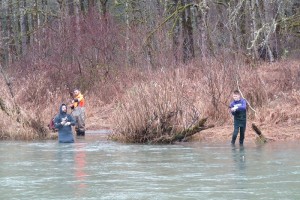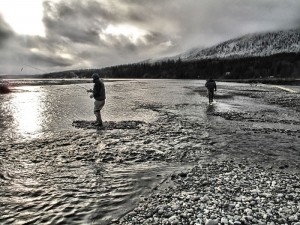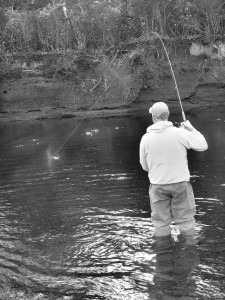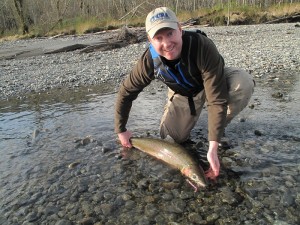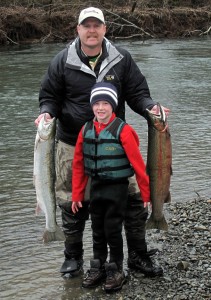Keys to Successful Bank Steelheading Leave a reply
by Jason Brooks
Bank bound anglers often feel they are at a hindrance to those floating buy in drift boats or having the wake of a jet sled slap the shores as they zoom by. But just because one is on foot doesn’t mean they are at a disadvantage as long as the bank angler utilizes some basic knowledge and prepares for the day of fishing. Here are a few keys to becoming a more successful bank bound steelheader.
Know the river and the land that surrounds it. With the internet and Google Earth as well as many other mapping systems like Hunt by “onXmaps”. A little research before you head to the water will benefit the angler on foot. Access points to some secret holes or runs can be found by simply clicking through the county auditor’s website and learning which bank areas are open to the public and who might own the private lands to ask for permission. River’s change course each winter with the heavy rains but Google earth will show you the bends and long straights with a tail out.
After you have done a search and found several access points to a river you want to fish, it’s time to put the boots on the ground. Take an entire day to explore the river and check out all potential access points and areas to fish. The first time you visit a river it should be to explore. Even if you find that secret run or deep slot, fish it for an hour and then make yourself move on and keep looking around. You will thank yourself the next time you drive to the river and find a person in your best spot and then not have to go try and find a new one as you will already know where to go.
Once you learn a river or two or three…you get the idea, then it’s time to get smart about your gear. When I bank fish, and yes, I still like the ease of hiking into a river and fishing instead of fighting the lines at the boat ramps. I usually take two rods, both are the same though. The idea is to have a back-up rod and reel outfit in case your primary one breaks, it happens, as my car door is notorious for eating rods in the parking lot. My “go to” steelhead outfit is a 9 ½ foot medium to light action spinning rod with a 3000 series reel spooled with 20 pound braid. This set-up allows me to fish multiple ways and a variety of water conditions.
The tackle box is where you can really get into trouble when it comes to bank angling. You need to pack just the right gear and right amount and carry it all throughout the day. This is where using a universal rod and reel like the one mentioned above really pays off. I will pack six spoons, three in ½ ounce and three in ¾ ounce so I can adjust to water speed. Since I am fishing braid I also bring along four adjustable ½ ounce floats, six or more jigs, a dozen “yarnie” pre-tied drift fishing leaders, another dozen leaders just plain, some pink worms and a few bare jig heads. I am not a big bait fishing fan when bound to the bank as you then need carry the bait and keep it fresh, but I do carry scents, such as Pro-Cure Super Gel in Anise, Sandshrimp, and Salmon Egg. By using the yarnies with scent I am essentially using a standard bait drift fish rigging. Don’t forget the swivels and weights, I prefer slinkies in various shot amounts depending on the water conditions. All of this goes into a backpack and takes up little room and is lightweight.
With the above mentioned rod and reel, and gear I can fish several methods and all water conditions. From throwing spoons, drift fishing yarnies and pink worms to float fishing jigs and “whacky” rigged worms and even a spoon under a float in a boulder garden, as well as bobber-dog a long run. I have stood at the top of a seam and bobber-dogged until my line on my spool was down to the last wrap. Now that it working the water!
Strap on the boots, check the river levels and head for the bank. By preparing and being armed with knowledge of the river you will be more successful. Just don’t smile too much as the boats go by, knowing they have to fight the lines at the launch.
Jason Brooks
Northwest Outdoor Writer



